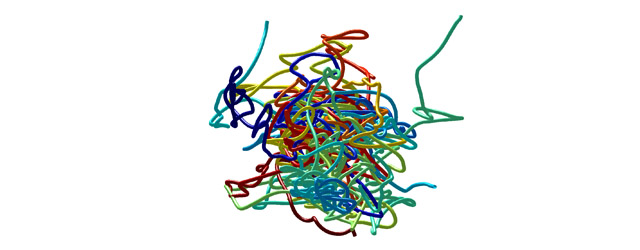Accueil
Reading between the lines of highly turbulent plasmas (Vol. 48, No. 3)

Study shows how to identify highly turbulent plasma signatures in the broadening of the shapes of lines emitted by ions and atoms within.
Plasma, the ionised state of matter found in stars, is still not fully understood, largely due to its instability. Astrophysicists have long-since sought to develop models that can account for the turbulent motions inside plasma, based on observing line shapes emitted by atoms and ions in the plasma. Turbulences are typically detected through the observation of broadened lines due to the Doppler effect, similar to the principle behind radar. In a new study published recently, the authors develop an iterative simulation model that accurately predicts, for the first time, the changes to the line shape in the presence of strong plasma turbulence. Ultimately, the authors aim to provide a system for assessing plasma turbulence that is valid for both a stellar atmosphere and the ITER tokamak designed to generate fusion energy.
R. Stamm, I. Hannachi, M. Meireni, H. Capes, L. Godbert-Mouret, M. Koubiti, J. Rosato, Y. Marandet, M. Dimitrijević and Z. Simić, Line shapes in turbulent plasmas, Eur. Phys. J. D 71, 68 (2017)
[Abstract]
Appearance of deformation in the yttrium isotopic chain (Vol. 48, No. 3)

In the isotopes of rubidium (Rb), strontium (Sr), ittrium (Y), zirconium (Zr) and niobium (Nb) (i.e., with Z=37-41), a sudden change of the nuclear structure occurs when the number of neutrons reaches N=60. While the nuclei with N<60 exhibit spherical shape in their ground states, the isotopes with N≥60 are significantly deformed. This phenomenon is considered the most dramatic shape change in the nuclear chart. A question was raised of whether the deformed structures appear just at N=60 or they reside also in the lighter isotopes. Indeed, deformed rotational bands built on the excited isomeric states are placed in 95Rb, 96Sr, 98Y, 98-99Zr, i.e., at N=58 and 59, however, nothing was known about location of such collective excitations at N<<58. In our work, it was possible to significantly develop the level scheme of 96Y57 via gamma-coincidence spectroscopy technique. During the analysis, a new 201(30)-ns isomeric state at 1655 keV excitation energy was located and the existence of a rotational band built on it was suggested. This result points to the presence of deformed structures already at N=57 which, with the increasing number of neutrons, gradually decrease in energy, to become dominant at N≥60.
L. W. Iskra and 35 co-authors,
New isomer in 96Y marking the onset of deformation at N = 57, EPL 117, 12001 (2017)
[Abstract]
Twisted waves in a magnetoplasma (Vol. 48, No. 3)

In recent years, the properties of twisted light beams have been widely explored. In particular, it was realized that twisted laser beams are able to excite twisted density perturbations in a plasma, and that these density perturbations are indeed new forms of twisted waves. Each twisted wave solution is characterized by a topological charge. A further step in the understanding of twisted light was recently made, by studying twisted wave solutions in a magnetized plasma. This leads to a variety of twisted wave solutions, both electrostatic and electromagnetic, depending on the angle of propagation with respect to the static magnetic field. These waves can also be seen as quasi-particles, carrying an intrinsic angular momentum, which is determined by the value of their topological charge.
Furthermore, the kinetic description of a gas of such quasi-particles can also be established. This leads to a generalized concept of plasma turbulence, made of a gas of several types of twisted quasi-particles. An example of application was considered, where two twisted modes with different topological charge interact with each other, exchanging energy and angular momentum inside the plasma.
J. T. Mendonça and J. P. S. Bizarro, Twisted waves in a magnetized plasma, Plasma Phys. Control. Fusion 59, 054003 (2017)
[Abstract]
Speed-dependent attraction governs what goes on at the heart of midge swarms (Vol. 48, No. 3)

New study reveals swarm cohesion stems from an adaptive behaviour, where the faster individual midges fly, the stronger the gravitational-like force they experience.
Ever wondered what makes the collective behaviour in insect swarms possible? The authors modelled the effect of the attraction force, which resembles Newton’s gravity force, acting towards the centre of a midge swarm to give cohesion to their group movement. In a recently published work, their model reveals that the gravity-like attraction towards the heart of the swarm increases with an individual’s flight speed. The authors confirmed the existence of such an attractive force with experimental data. They chose to focus on insect swarms, rather than bird flocks or fish shoals, because interactions between neighbouring individuals appear not to play a key role. This makes insect swarms easier to model. Instead of building a model describing the microscale movement of individuals and confronting it with experimental data, the authors built a model of swarm behaviour that is consistent with experimental observations, in terms of swarm density, of individual midges’ speed and acceleration.
A. M. Reynolds, M. Sinhuber and N. T. Ouellette, Are midge swarms bound together by an effective velocity-dependent gravity?, Eur. Phys. J. E 40, 46 (2017)
[Abstract]







